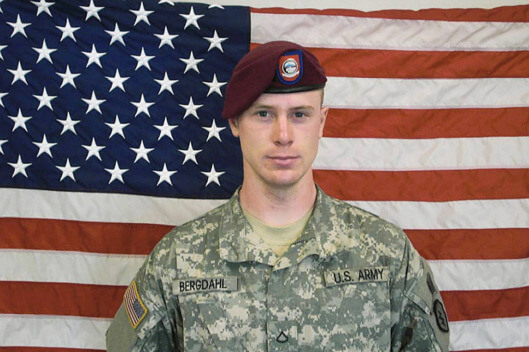Serial Recap: When Bowe Bergdahl Met Adnan Syed… Sort of

Bowe Bergdahl, Getty Images
Last week, I got to interview This American Life and Mystery Show veteran Starlee Kine (look for it in an upcoming issue!), and, of course, we spent some time talking about Serial. “It palpably changed the environment,” of podcasting, she told me. “I wouldn’t even compare it to This American Life. It pales in comparison. Everything pales in comparison. If you talk about a This American Life episode, you’re just recycling what you hear. Serial was an interactive thing that you could debate. It’s a different thing, and you’re participating in something.”
If season one of Serial turned a microscope on its subject—basically, what some teens did on one afternoon in the 90s, suddenly significant because one of them ended up dead—then season two uses a telescope to look at a whole constellation of issues, including warfare, psychology, terrorism, politics, and a lot more. You’d think that widening the scope in the way season two has would make it more compelling, not less. Yet that doesn’t seem to be what’s happening. It’s lacked that interactive, engrossing element Kine was talking about.
But maybe I’m the only one who feels like this. For all the constructive criticism (or you might say negativity) I’ve thrown at Serial the last few months, a quick glance at the iTunes podcast charts shows that literally from the day season one premiered, on December 10 of 2015, it’s been sitting tight at #1. That’s two consecutive months at the top of the charts, and no signs of slowing down.
Especially because this week, we got not one, but two episodes! One continues the saga of Bowe Bergdahl (a man whose name I am by now very good at spelling), while the other dives us back into the world of Adnan Syed from season one, who’s back in court for new hearings. In this mini-ep, Koenig promises to bring us daily updates (!!) as long as those hearings go on.
So, what’s up? Adnan is currently engaged in a hearing, a continuation of his petition for post-conviction relief. He first filed that petition back in 2010, years before Koenig or any of us ever heard of this case. His argument is that his lawyer in his original trial was so incompetent that he deserves to have his conviction overturned. As you may remember, his attorney, Cristina Gutierrez did things like start a fight with the judge in open court and ask for suspiciously large cash payments from his family. Guiterriez was ill throughout Adnan’s case, and died just a few years after it finished. This illness, and her declining faculties, play a part in Adnan’s arguments now about why he should get off, or at least get a new trial: She was so sick that she wasn’t able to do a good job.
Another big part of Adnan’s case this time has to do with Asia McClain, his classmate who claimed that she was with Adnan during the time that his ex-girlfriend, Hae Min Lee, was killed. She wrote him a letter saying this before his first trial a decade ago, but Adnan’s lawyers never reached out to her. Knowing about this letter, and the alibi it represented, is what got Koenig interested in Adnan’s case in the first place. Since the show aired, fascination with her, and speculation about whether or not she’s telling the truth, has been a big part of Serial mania.
Well, now a judge gets to decide. This episode, Koenig, talking from the closet of a Baltimore hotel room, tells us about watching McClain stride into court, looking strong and beautiful, and unwaveringly laying out her case. Yes, she was with Adnan. Yes, she remembers it. The prosecution now has to prove that this testimony wouldn’t have made a difference in the original trial. So, they’ve already started trying to show that maybe McClain’s memory isn’t as great as she thinks, and the original prosecutors wouldn’t have had any trouble poking holes in it.
More updates there in the next episode!
Now, back to Bowe Bergdahl.
This week’s episode focuses back tightly on him and his motivations for walking off that base in Afghanistan. Bergdahl, by all accounts, was seeking extremes. Through interviews with him and his fellow soldiers, we learn that he joined the military already having a firm idea of what it was going to be like. Unfortunately, it was based on a hodgepodge of movies and video games, and not reality. Whenever his fantasy and his real life came into conflict, Bergdahl didn’t deal with it well.
When he first got to his barracks in Afghanistan, he was disappointed that they were too comfortable. He fixed this problem by putting his mattress on the floor and sleeping on the bedsprings (not box springs, his former comrades point out, but literal exposed metal springs). He slept with a tomahawk on his chest, because he wanted to prove what a good soldier he was. He studied military manuals at night. He was widely known to be, in a lot of ways, the perfect solider. He felt ashamed that when his platoon came under fire in one memorable incident, he had to sit in the truck for protection, and didn’t go out and fight. He was confused and frustrated that they were engaged in trying to support and work with the Afghan people, when he thought that he was there to go and shoot people. At the same time, hearing an official joke that being in the army meant more than “raping and pillaging,” made him bitterly disappointed. How could people talk like that?
More than anything, though, Bergdahl seems to have had a powerless person’s overdeveloped sense of fairness. He could deal with his position—a lowly grunt in maybe the most hierarchical organization on the planet—as long as he thought that what he was being asked to do was fair. When it seemed like it wasn’t, he couldn’t take it. When a commander yelled at them for being out of uniform, or he heard secondhand that there’d been a crack about the platoon not shaving while stuck in a dangerous position for a week, he reacts with palpable anger, even now. At one point, he’s railing about his belief that a commander might “purposely put him in harm’s way,” seeming not to realize that’s a major part of the job of being a commander. The hard truth is that for all the military’s talk of brotherhood, which is both true and deeply felt, an individual solider is there to do a job, and his comfort and even survival are important, but not really necessary.
But to really understand these complaints, and whether or not they have any merit, we have to zoom way, way out and consider the whole nature of what the US was doing in there, and maybe even the whole concept of war itself. Is there such a thing as a reasonably conducted war? A “safe” position on a battlefield? A decision made in the heat of combat that truly stands rational scrutiny years later, or even hours later? Bergdahl seems to have been convinced that it’s possible to have all of this. He joined the military after all. He believes in this stuff. But the reality of it left him pretty cold. Was there really anything wrong with his platoon, or is war just inherently a bad idea?
At the end here, I’d like to take an aside here to talk about Counter Insurgency thinking in the military (COIN, for short), which gets a little abuse in this episode. Championed by General David Petraeus, the military’s COIN manual was adopted in 2009 to help with the wars in Afghanistan and Iraq, just as Bergdahl was being deployed. This episode contains some military guys and Koenig herself trotting out an old argument against COIN: soldiers are trained to kill, not to build. You can’t ask guys who’ve just been in military training, which is focused on ending other people’s lives, and ask them to walk around a foreign country leading city council meetings and handing out candy.
That’s true enough in some ways. But I was actually getting my masters in international affairs right around this time, and I’ve read the COIN manual, so I’d like to take up its defense a little. The reason COIN exists is because the military—America, more broadly—is in Iraq and Afghanistan to win. Not just to murder people, but to defeat its enemy, Al Qaeda (and to a lesser extent, the Taliban).
How do you defeat an enemy that can melt into the population, and can recruit anyone who might be dissatisfied with their life? Demonstrably, whether it’s Viet Nam or the early days of the Iraq invasion, you can’t drop enough bombs or kick in enough doors to really and truly stop a popular movement like Al Qaeda or ISIS. So, the thinking in military circles started to go, maybe the way you defeat them isn’t just invading, building a fort, and only coming out to kill people. That’s a strategy that’s basically never worked for all of military history. Maybe what you really should do is help the country get back on its feet, and try to inspire some feeling other than terror in the local population. Anyone who knows any real people who’ve served in the military knows they already do a lot more than kill people: Helping with disaster relief around the world (ie, handing out food) is a regular part of a lot of the work of our military deployed overseas. So, this isn’t as crazy as it might seem from this episode. Even if, as a 20-year-old out of the country for the first time with dreams of Call of Duty floating in your head, it seems like it’s not what you signed up for. But, then, maybe there’s a reason 20-year-olds don’t get to decide military policy.
Next episode, we continue our journey through the foggy, conflicted mind of Bowe Bergdahl. What’s going on in there?
You might also like 



















